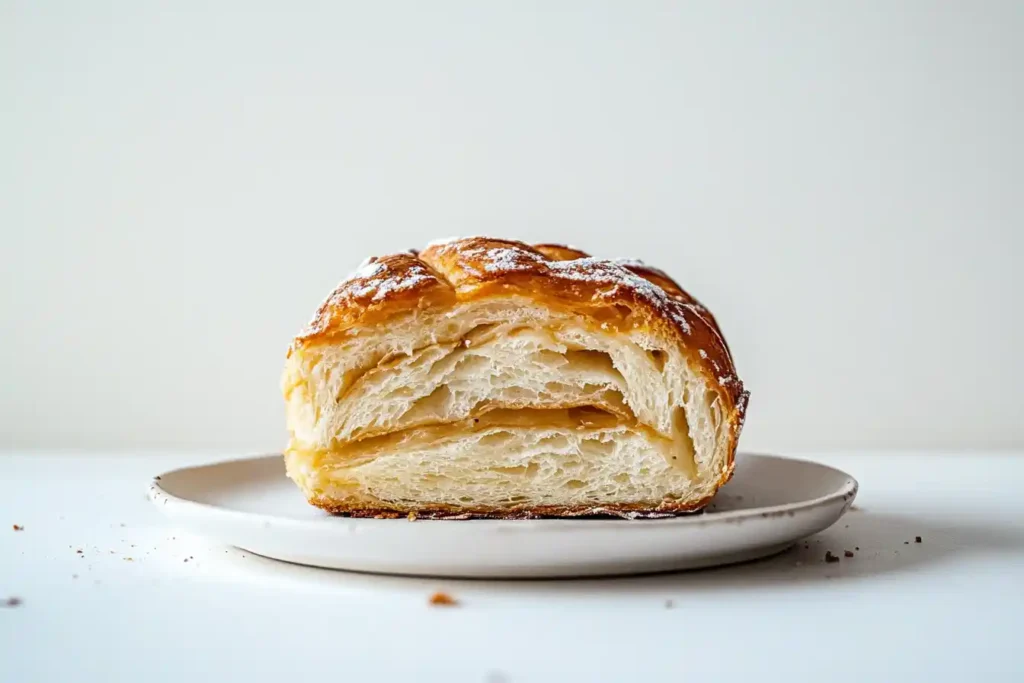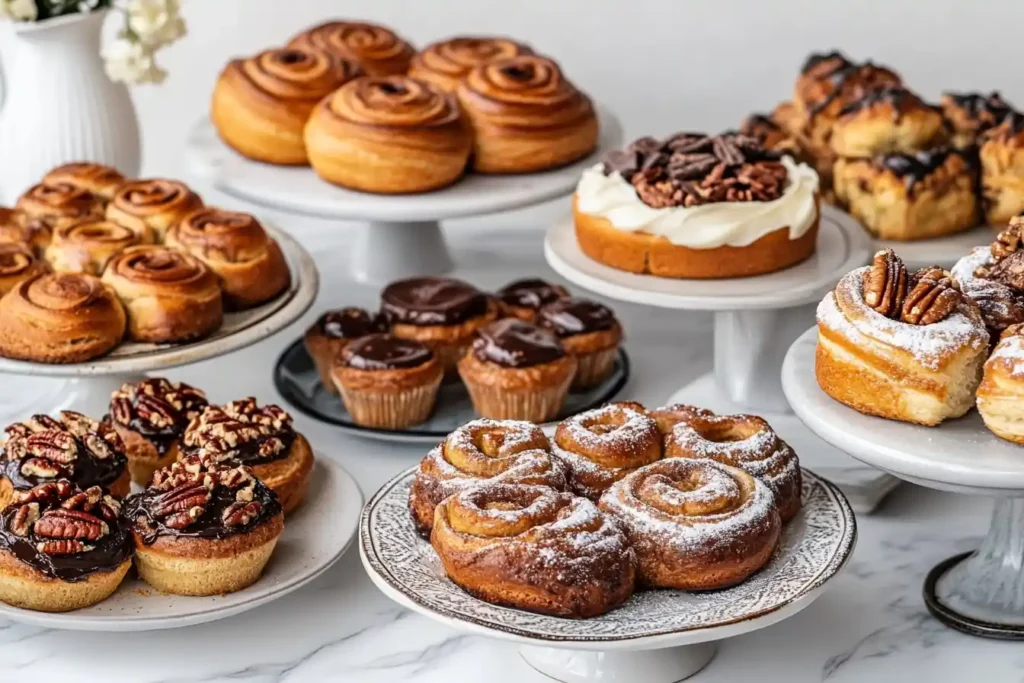Historical Background
Origins of Chelsea Buns
The Chelsea bun, a true British classic, traces its roots back to the early 18th century. Originally crafted at the Chelsea Bun House in London, this pastry quickly became a favorite among locals and royalty alike.
Made with enriched yeast dough, currants, and mixed spices, it was a luxurious treat in its time. Over the years, the bun’s popularity spread, making it a staple in traditional British baking. The addition of sticky glaze enhanced its appeal, solidifying its status as a quintessential English dessert.
Origins of Cinnamon Rolls
On the other side of the globe, cinnamon rolls—also known as “kanelbullar” in Sweden—have their roots in Scandinavia. Emerging in the 1920s, they became a staple in Swedish coffee culture, often served during “fika” (a coffee break with pastries).
Unlike the Chelsea bun, cinnamon rolls focus heavily on the warm, spicy aroma of cinnamon combined with sugar, as seen in this cinnamon roll muffins recipe.. As they migrated to North America, these rolls evolved, incorporating cream cheese frosting, which added a decadent touch.
Their journey showcases a transformation from European sophistication to American indulgence.
Evolution Over Time
While both pastries started in Europe, their evolution reflects their cultural contexts. The Chelsea bun retained its traditional British character with minimal changes to its original recipe.
Meanwhile, cinnamon rolls adapted to diverse preferences, becoming sweeter and creamier in the U.S. Today, both continue to thrive, each representing a unique aspect of baking heritage. But one thing’s for sure—they’ve become beloved treats that transcend borders.
Ingredients and Preparation
Dough Composition
When comparing Chelsea buns and cinnamon rolls, their foundation lies in the dough, yet subtle differences set them apart. Chelsea buns are made using an enriched dough, often containing milk, butter, and eggs, resulting in a slightly dense yet soft texture.
The addition of these ingredients gives the buns their signature richness and makes them hearty and satisfying. In contrast, the dough for cinnamon rolls leans toward being fluffier and lighter, with more emphasis on achieving a soft, pillowy consistency.
The yeast is a common component in both, ensuring that the dough rises beautifully, but the kneading and proofing methods can vary slightly, contributing to their distinct textures. Moreover, Chelsea buns may include spices like nutmeg or cinnamon directly in the dough, creating a subtle warmth in every bite.
Filling Variations
The fillings truly highlight the contrasting flavors of these two pastries. Chelsea buns are characterized by a currant-based filling mixed with brown sugar, butter, and spices like allspice or cinnamon. This mixture lends a fruity sweetness balanced with a touch of earthiness. Occasionally, raisins or candied peel are added for extra texture and zest.
Cinnamon rolls, however, keep things simpler but bolder. The filling is typically a blend of cinnamon, sugar, and butter spread generously over the dough. Some recipes elevate this with a pinch of cardamom or a sprinkle of chopped nuts, but the focus remains on the spicy-sweet contrast that cinnamon delivers.
Glazing and Toppings
Nutritional Comparison of Chelsea Buns and Cinnamon Rolls (Per 100g)
| Nutrient | Chelsea Buns (Per 100g) | Cinnamon Rolls (Per 100g) |
|---|---|---|
| Calories | 340 kcal | 420 kcal |
| Protein | 5 g | 6 g |
| Carbohydrates | 56 g | 62 g |
| Sugar | 25 g | 32 g |
| Fat | 10 g | 16 g |
| Saturated Fat | 4 g | 8 g |
| Fiber | 2 g | 1 g |
| Sodium | 240 mg | 290 mg |
Once baked, both pastries are adorned with their unique finishing touches, adding visual appeal and flavor. Chelsea buns are coated with a sticky glaze made from sugar and water or golden syrup, giving them a shiny, caramelized finish. This glaze not only enhances the bun’s sweetness but also preserves its moistness.
Cinnamon rolls, on the other hand, are celebrated for their luxurious icing. A creamy topping made from powdered sugar, butter, milk, and often cream cheese is drizzled or spread over the warm rolls. This creamy addition complements the cinnamon’s spice, creating a dessert that’s as decadent as it is irresistible.
These preparation differences show that while both pastries share similarities in their dough-making process, their flavors and finishing touches offer distinctly different experiences.
Taste and Texture Profiles
Flavor Differences
When it comes to flavor, Chelsea buns and cinnamon rolls offer uniquely satisfying experiences that cater to different palates.Chelsea buns are a harmonious blend of subtle sweetness, spiced undertones, and fruity bursts from currants or raisins, similar to the balance in this blackberry cheesecake recipe. The inclusion of mixed spices and a sticky glaze enhances the natural flavors, making the bun taste rich yet balanced. Each bite is layered with warmth and a hint of caramel from the golden syrup or sugar glaze.
Meanwhile, cinnamon rolls bring a bolder, more concentrated sweetness to the table. The cinnamon sugar filling is the star of the show, creating a sweet-spicy combination that’s both aromatic and indulgent. The frosting—often cream cheese-based—adds a creamy, tangy dimension, making it a dessert that leans heavily into decadence. The result is a treat that’s irresistibly rich and distinctly American in flavor.
Texture Contrasts

The textures of these two pastries also differ significantly, shaping the eating experience. Chelsea buns have a firmer, denser bite due to the enriched dough and the caramelized glaze that adds a sticky, chewy surface. The currants provide a pleasant burst of juiciness, while the spiced layers offer a balanced complexity. This slightly chewy texture makes them perfect for savoring alongside a cup of tea.
Cinnamon rolls, however, are known for their soft, fluffy consistency. The dough is often airy and tender, almost melting in your mouth when fresh out of the oven. The buttery cinnamon filling creates a gooey interior, while the creamy frosting atop adds an additional layer of softness. This combination results in a pastry that feels luxurious and comforting in every bite.
Savoring the Differences
While Chelsea buns are ideal for those who enjoy a mix of fruity, spiced flavors with a touch of stickiness, cinnamon rolls are perfect for those who crave indulgent, sweet, and creamy desserts. The texture and flavor profiles of these pastries not only differentiate them but also ensure that they appeal to a broad spectrum of dessert lovers.
Cultural Significance and Popularity
Chelsea Buns in British Culture
Chelsea buns hold a special place in British culinary heritage. Originating in London during the 18th century, these sweet treats were a favorite among the working class and aristocracy alike. The Chelsea Bun House, where they were first made, was so renowned that it attracted customers like King George II and his family. These buns became synonymous with traditional English tea culture, embodying the country’s penchant for subtle, refined flavors.
Even today, Chelsea buns are a cherished part of British baking. They are staples at bakeries across the UK, often served as a mid-morning snack or a companion to afternoon tea. Their enduring popularity reflects Britain’s love for nostalgic, homey desserts that celebrate its culinary history.
Cinnamon Rolls in North American Culture

In North America, cinnamon rolls are more than just a breakfast pastry—they’re a cultural phenomenon. Their arrival on the American scene transformed them from a Scandinavian treat into a sweet, decadent icon. Whether served at family gatherings, during holidays, or as an indulgence at local diners, cinnamon rolls have become a comfort food staple.
Brands like Cinnabon have commercialized these rolls, making them widely available and instantly recognizable. The rich, gooey frosting combined with the spicy-sweet filling appeals to America’s love for bold, flavorful desserts. Cinnamon rolls have also become popular at brunches, fairs, and coffee shops, solidifying their role as a quintessential part of American food culture.
Global Popularity and Variations
Both pastries have traveled beyond their origins, adapting to local tastes and ingredients worldwide. In Europe, Chelsea buns remain a staple, with slight regional tweaks, such as the use of dried cherries or marzipan. In the U.S., variations like pecan-studded sticky buns often rival the traditional Chelsea bun. Meanwhile, cinnamon rolls have undergone transformations across the globe, from cardamom-infused versions in Sweden to chocolate-filled twists in other regions.
In modern times, these pastries continue to bridge cultures, with chefs and bakers blending techniques to create hybrid versions that honor both traditions. This widespread popularity proves that whether you’re enjoying a sticky, spiced Chelsea bun or a creamy, indulgent cinnamon roll, these pastries bring people together, celebrating the universal love for sweet, baked delights.
Frequently Asked Questions About difference between Chelsea buns and cinnamon rolls
Not exactly. While both use enriched yeast dough, Chelsea buns often have a slightly firmer texture due to the inclusion of milk and butter, while cinnamon rolls focus on achieving a softer, fluffier consistency.
Yes, traditionally Chelsea buns are filled with currants or raisins, along with spices and brown sugar. However, some variations might include other dried fruits or candied peels for a twist.
Cinnamon rolls tend to have a sweeter profile due to their generous cinnamon-sugar filling and the addition of creamy frosting, whereas Chelsea buns rely more on the natural sweetness of currants and a sticky glaze.
Although they share similar bases, substituting one for the other might alter the intended texture and flavor of the dish. For instance, the fruitiness of Chelsea buns and the bold cinnamon flavor in cinnamon rolls aren’t interchangeable without affecting the outcome.
Conclusion of the Difference Between Chelsea Buns and Cinnamon Rolls
Though Chelsea buns and cinnamon rolls may look similar at first glance, their distinct flavors, textures, and cultural significance make each an extraordinary creation in its own right. These beloved pastries are a testament to the diversity of culinary traditions, showcasing how a simple idea of sweet rolls can evolve into two unique forms.
Chelsea buns, with their soft, enriched dough filled with fruity currants and topped with a sticky glaze, are a delicious celebration of British baking heritage. Originating in the 18th century, they carry a sense of nostalgia and tradition that makes them a cherished treat even today. Their delicate balance of sweetness and spice reflects the refined taste often associated with English desserts, perfect for pairing with a comforting cup of tea.
In contrast, cinnamon rolls are a bolder, more indulgent pastry that has taken on iconic status in North America. Their sweet cinnamon-sugar filling, rolled generously into pillowy dough, and crowned with creamy frosting create a dessert that is rich, satisfying, and utterly decadent. Cinnamon rolls have transcended their Scandinavian origins to become a beloved staple at brunch tables, coffee shops, and bakeries across the continent, embodying a sense of comfort and indulgence.
Both pastries also highlight the artistry involved in working with enriched dough and the creativity of bakers who have perfected these recipes over centuries. From their preparation methods to their cultural roots, Chelsea buns and cinnamon rolls offer different yet equally delightful experiences. One leans toward the subtle, spiced fruitiness that is quintessentially British, while the other embraces the bold, sweet decadence that Americans adore.
Whether you’re savoring the spiced, fruity warmth of a Chelsea bun or the gooey, frosted sweetness of a cinnamon roll, these treats exemplify the universal love for pastries. They remind us that food not only satisfies the appetite but also connects us to traditions, cultures, and memories. Why not indulge in both and explore the unique flavors and textures they offer? You might find yourself loving one more—or equally treasuring both for their undeniable charm and deliciousness.

